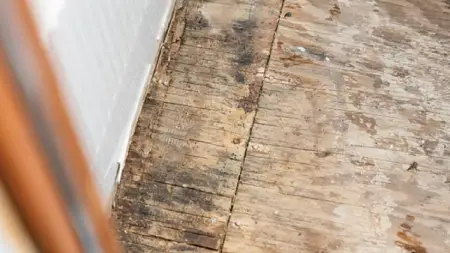 Does your home have dry rot? Would you know if it did?
Does your home have dry rot? Would you know if it did?
According to Rainbow Restoration, dry rot is a serious wood decay issue that can compromise the structural integrity of a home.
|
Dry rot can happen in any climate to any type of wood, and it can ruin the structure, whether it occurs inside or outside. Some of the most common places to find dry rot are attics, windowsills, steps, decks, eaves, fencing, under sinks, and in basements.
Read on to learn everything you need to know about identifying dry rot, and how to prevent it.
What Causes Dy Rot?
Dry rot is a breakdown of wood caused by a fungus. Dry rot affects the cellulose and the hemicellulose in the wood, two components that give wood its strength, stability, and longevity. When the fungus attacks the wood, it compromises the integrity of the cellular structure, leaving it weak and brittle.
Despite the word “dry” in the name, the fungus that causes dry rot typically grows when the moisture in the wood exceeds 20 percent, or when the wood is exposed to sitting water or extreme humidity.
Dry Rot vs. Wet Rot
Dry rot is oftentimes confused with wet rot but is easy to identify once you know what to look for. If you’re looking to identify the type of rot present on your property, keep these clues in mind:
The primary clues to look for in dry rot:
- A yellow tinge on the surface indicates the presence of a fungus
- Deep cracks in the wood
- The wood will crumble
- Less advanced rot is noticeable on nearby wood due to the spread of the fungus spores
Clues to look for in wet rot:
- Wood that feels wet to the touch, or that has a musty smell and feels soft and spongy
- Wood that has shrunken or looks sunken
- The surface has a black fungus on it
When is Dry Rot Most Likely to Occur?
Because moisture is necessary for the particular fungus that causes dry rot, there are typical situations in which dry rot is found:
- After a flood or natural disaster
- After a plumbing accident, like a burst pipe
- In extremely humid climates
- When wood is not properly dried before being used
How Can I Protect My Home from Dry Rot?
The best way to prevent dry rot is to keep the wood inside and outside your home free from excess moisture and water exposure. Protect it by following these guidelines:
- Make sure a professional installs your wooden siding, and that it’s properly sealed.
- Be sure to prime the exterior of your home before painting it to protect the wood from the elements.
- Have a roofing company inspect your roof annually to check for leaks or holes that can let water in and cause dry rot.
- Make sure you have effective, properly installed gutters to direct water away from your home.
- Check your plumbing in your basement and under sinks to be sure you don’t have unnoticed leaks.
- Install or upgrade proper ventilation in bathrooms, kitchens, and attics to remove excess moisture from inside your home.
- Seal, stain, or paint your deck with appropriate exterior products that will protect the wood from wet weather.
Choose Rainbow Restoration for Water Damage Remediation
Floods happen, and when they do, the best way to protect your home is with quick action and 24/7 emergency response from a professional restoration company like Rainbow Restoration. You can count on us for flood and water damage restoration services you can trust. Our services get your home back to normal and prevent secondary damage from occurring.
Get started with Rainbow Restoration water restoration services today. Schedule an appointment online or contact the Rainbow Restoration nearest you.
